The converging demands of aesthetics, performance, sustainability, and occupant experience today are simply the price of entry into creating for the built environment. For architects and interior designers, this presents new challenges and opportunities: Designing beautiful, high-performing structures that benefit both people and the planet means merging the loftiness of an artistic vision with managing the very practical realities of air quality, acoustics, temperature regulation, and environmental impact.
Addressing these challenges often begins with material selection—and, to a larger degree, specifying an assemblage of materials and products that, together, all seamlessly rise to the needs of both creative inspiration and functional performance. This is a driving factor behind CertainTeed’s portfolio. From ceilings and drywall to insulation, vapor barriers, and more, the company offers a broad spectrum of cohesive systems and complementary products designed to work together, making it easier to deliver on what matters most: performance, sustainability, and longevity.
Thanks to their deep, industry-leading knowledge in building science and an intelligent systems-based approach to build for optimum performance, energy efficiency and occupant experience, CertainTeed and Saint-Gobain take a fully integrated, human-centric angle in the way materials are engineered and how products perform.
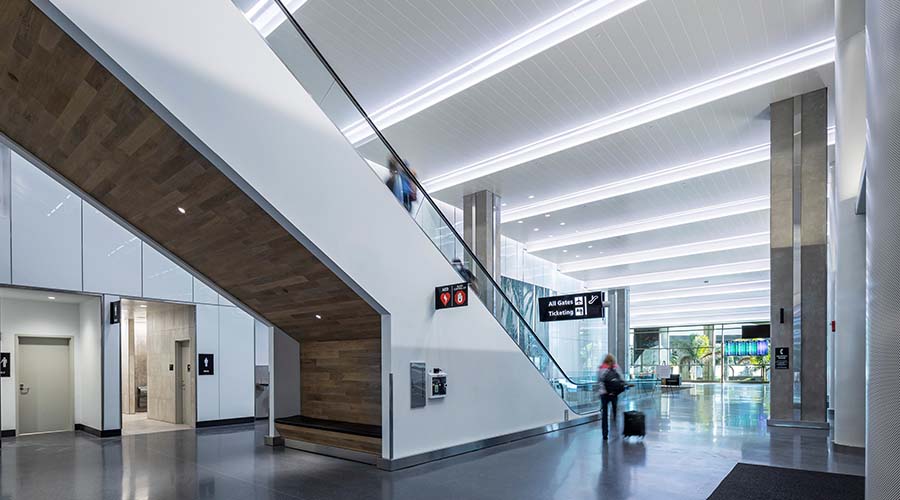
Photo © Studio 66 LLC, Click to enlarge.
A Ceiling for Aviation Innovation
One example of CertainTeed solutions in action can be found at Tampa International Airport (TPA), which sees upward of 30 million travelers pass through its gates annually. Over the years, the 70s-era terminal has been hailed for its novel landside/airside design; however, a recent expansion and renovation project has modernized the facility for the demands of today’s air travel.
The three-phase project increases the airport’s capacity and updates its amenities and performance. Phase 2, which focused on the Main Terminal, broke ground in 2019, with a massive metal CertainTeed ceiling playing a large part in aesthetics, wayfinding, and acoustical optimization.
The scale of the ceiling alone created its own level of complexity. More than 215,000 feet—40 miles—of CertainTeed Architectural 300C Interior and Exterior perforated metal linear planks were installed throughout the terminal and its exterior departure/arrival canopies, creating a seamless visual transition from the exterior to the interior. Additionally, 3,100 CertainTeed Architectural Multi-Box Continuous linear metal ceiling panels infuse the Blue Side Passenger Transfer Area ceiling plane with clean, modern lines.
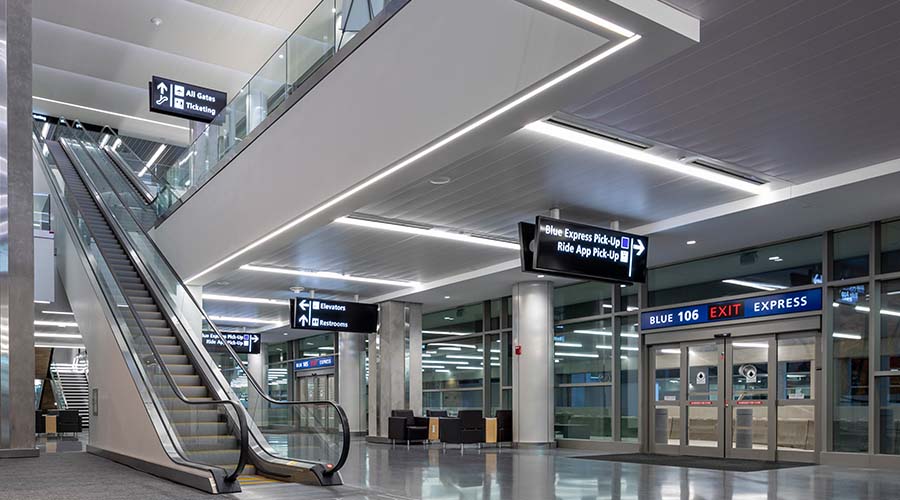
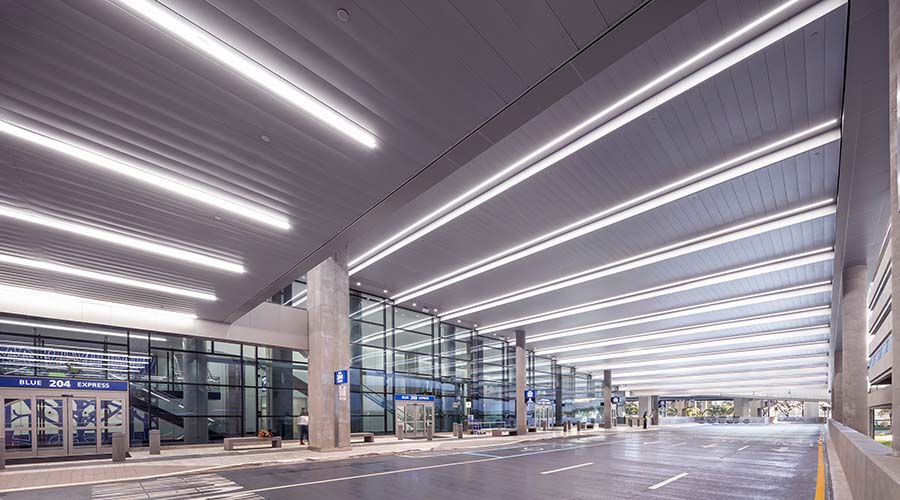
Photos © Studio 66 LLC
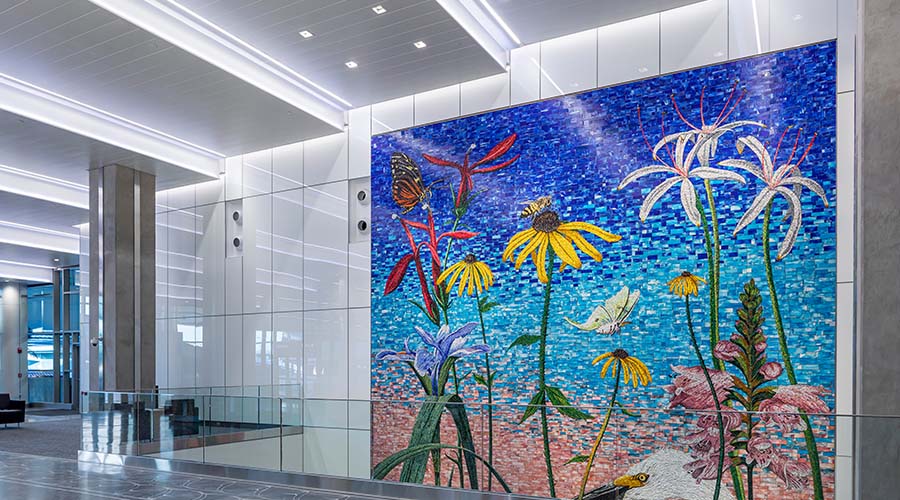
The architects and designers at HNTB designed tiered sections into the ceiling to create movement that reflects the fluidity with which travelers arrive to and depart from the terminal. The multi-level design seamlessly connects the main interior ceiling to the roadway canopy, which then follows the curvature of existing ramps that provide access to an overhead parking garage. The design works naturally with the flow of automobile and foot traffic across TPA’s vast open spaces.
Throughout the terminal, acoustical control is strategically designed into the ceiling. Panels with acoustical performance are deliberately positioned in high-traffic areas to absorb the ambient noise from masses of travelers passing by. It infuses a level of calm into the often hurried, stressful travel experience for air passengers making their way to destinations across the world.
To those entering and exiting the Main Terminal, the ceiling appears to be one system. However, the design belies the collaborative problem-solving between the engineering team, the ceiling contractor, and CertainTeed that successfully addressed a complex building challenge. It required multiple iterations in design development, as well as approvals from various levels of engineers, architects, code officials, and contractors, to ensure a cohesive aesthetic while controlling acoustics, meeting wind load requirements for extreme weather, and providing easy access to the plenum for necessary airport maintenance.
The CertainTeed technical support team collaborated closely with the designers and installers throughout the project to manufacture custom panels, create the custom support structure that holds it all together, and solve tricky installation challenges.
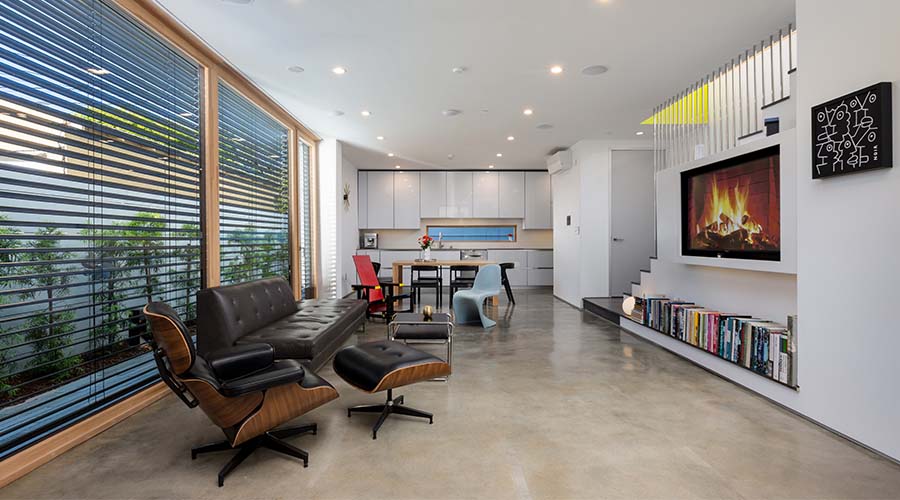
Photo © Fraser Almeida
Increasing Comfort and Sustainability with Gypsum
In the United States, designers, builders, and consumers are beginning to embrace passive house standards. Passive house construction involves material selections and building techniques that can reduce a structure’s energy consumption up to 90% while delivering spaces that are also healthy and comfortable for the people inside.
The primary challenge is the perception that passive house construction requires significantly more up-front costs to builders and homebuyers. By some counts, the initial building costs can be as little as 3% to 5% higher—costs that are quickly offset by the significant energy cost savings. Plus, passive house standards offer the appeal of consuming far less energy over a structure’s lifespan, which addresses the fast-growing need for sustainable building to curb environmental impact.
Sustainability, for good reason, often receives the primary focus in modern building projects. It’s critical, however, that occupant well-being doesn’t get lost in that focus. Passive House Los Angeles is a living example that Paravant Architects designed as both a proof of concept for sustainable building and a comfortable home.
The home features a modest 1,750 square feet of living space with a large deck area that also serves a dual purpose of carport. Large floor-to-ceiling windows offer an abundance natural light and a connection between indoor and outdoor spaces, and an airtight building envelope yields significant energy cost savings.
As building occupants are constantly subjected to ambient sounds they neither want nor benefit from, successfully designed residential and commercial environments must take acoustics into account. Acoustically attenuated spaces have been shown to enhance speech intelligibility, promote focus, improve sleep quality, and nurture comfort. One of the more consequential specification decisions came down to the drywall material Paravant Architects selected: CertainTeed SilentFX® Noise-Reducing Drywall.
From an aesthetic view, gypsum isn’t the first material designers turn to in their design processes. It can be difficult to even tell the difference from one drywall product to another—until you look below the surface and understand how select products are cleverly engineered with performance features that reduce environmental impact and enhance interior comfort. CertainTeed SilentFX Noise-Reducing Drywall is engineered with two dense gypsum layers and an inner layer of viscoelastic polymer that acts like a shock absorber to dampen sound energy and optimize acoustics. The innovative construction prevents sound vibration from traveling from room to room, resulting in increased Sound Transmission Class—and increased comfort for occupants in all areas of them home.
SilentFX is GREENGUARD® Gold Certified, and also features CertainTeed M2Tech® technology, which provides enhanced moisture and mold resistance so support indoor air quality.
The net result is an innovative home that promotes the well-being of its occupants.
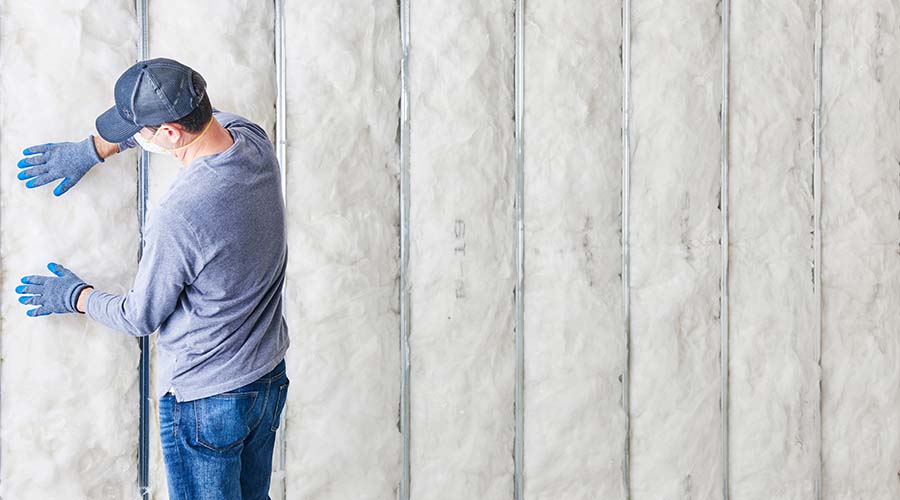
Photo © Studio 66 LLC
The Unseen Performance Element: Insulation
Like drywall, insulation is not a material that rises to the top of design considerations, particularly because it isn’t visible in the finished product. But also, like drywall, insulation can have a significant impact on a building’s performance.
A high-performance insulation product can be jack-of-all trades, contributing to moisture management, thermal efficiency, indoor air quality, and sound control. And for these purposes, there’s no better type of insulation than fiberglass.
Because fiberglass insulation neither absorbs nor holds water, it mitigates moisture buildup. It is also resistant to mold and microbial growth, making it an excellent choice to maintain indoor air quality
CertainTeed InsulPure™ fiberglass insulation is a thoughtfully engineered solution that prevents moisture accumulation and maintains a consistent R-value for long-lasting thermal control across its life cycle. It also contributes reduced noise levels and meets the GREENGUARD Gold standard for VOC emissions.
InsulPure works seamlessly with CertainTeed interior products to create complete systems that consume less energy and offer greater comfort.
Beyond Products
Ultimately, building is about more than products—it’s about people. And CertainTeed building systems are engineered with people in mind first: The professionals who design with the company’s products every day, and the occupants within the structures they create. The entire CertainTeed portfolio is backed by direct support from in-house product representatives, technical experts, and building scientists to help solve any building challenge with a focus on well-being and sustainability.
By Lucas Hamilton, Applied Building Sciences Manager, CertainTeed.







Post a comment to this article
Report Abusive Comment